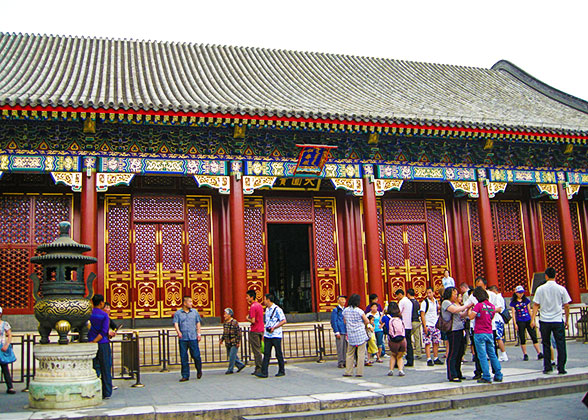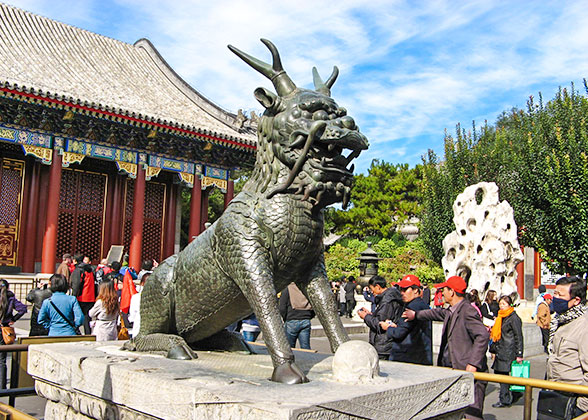Hall of Benevolence and Longevity (Renshoudian)
 |
| Hall of Benevolence and Longevity |
Actually, the Emperors' administrative hall was originally called "Qinzheng Hall" to inspire rulers to manage state affairs diligently. However, during Emperor Guangxu's time (1875 - 1908), the hall's name was changed to "Renshoudian" (Hall of Benevolence and Longevity), from the famous Confucian saying -"the ruler who reigns benevolently will have a long life".
Today, the furnishings in the hall remain as they were in the past. In the midst of the hall is a platform with a throne furnished with nine dragons, along with delicate peacock-feather fans, a monster-shaped censer, and a red sandalwood screen. The screen is more elaborate than other screens. Framed with sandalwood carved with nine dragons on the top, the middle part is a glass mirror engraved with 226 characters of "shou" symbolizing longevity in different ways. The Empress Dowager Cixi managed the affairs of court unseen, from behind the screen. Two side chambers of the hall served as the resting place of Emperor Guangxu , Empress Dowager Cixi, and other officials. Among the fine exhibits inside is a silk craftwork of one hundred bats with the Empress Dowager Cixi's calligraph "shou (longevity)". In Chinese speech, the words "happiness" and "bat" have similar tones. Therefore this craftwork was also named "one hundred bats holding longevity".
 In the courtyard there is an exquisitely sculpted bronze beast called a Kylin, with dragon head, lion tail, deer horn, and cattle hoof. In legend, the Kylin guards against destruction by fire. It is one of the relics of Yuanmingyuan (the Perfection and Brightness Garden). Five Lake Tai stones entitled "Fengxuwulao" also stand in the courtyard signifying longevity. In front of the hall are two pairs of bronze statues of dragons and phoenixes used as incense burners to perfume the air on formal occasions. Because the Empress Dowager Cixi, rather than the Emperor, managed the affairs of the state, the phoenix statues, which represent the queen, lie in the middle of the courtyard. The dragon statues, representing the Emperor, lie to the side, contrary to tradition. To the north of the hall is a well called "Yannianjing" (Well of Extending Life). It is said that the Empress Dowager Cixi once had a heat stroke and was revived when she drank the clear, sweet water from the well. Hence the well received its present day name.
In the courtyard there is an exquisitely sculpted bronze beast called a Kylin, with dragon head, lion tail, deer horn, and cattle hoof. In legend, the Kylin guards against destruction by fire. It is one of the relics of Yuanmingyuan (the Perfection and Brightness Garden). Five Lake Tai stones entitled "Fengxuwulao" also stand in the courtyard signifying longevity. In front of the hall are two pairs of bronze statues of dragons and phoenixes used as incense burners to perfume the air on formal occasions. Because the Empress Dowager Cixi, rather than the Emperor, managed the affairs of the state, the phoenix statues, which represent the queen, lie in the middle of the courtyard. The dragon statues, representing the Emperor, lie to the side, contrary to tradition. To the north of the hall is a well called "Yannianjing" (Well of Extending Life). It is said that the Empress Dowager Cixi once had a heat stroke and was revived when she drank the clear, sweet water from the well. Hence the well received its present day name.
![]() Next: Garden of Virtue and Harmony
Next: Garden of Virtue and Harmony
![]() Related Link: Summer Palace Travel Tips
Related Link: Summer Palace Travel Tips